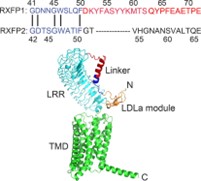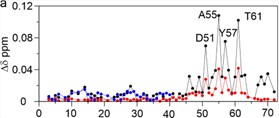RXFP1
-
Official Full Name
relaxin/insulin-like family peptide receptor 1 -
Overview
Relaxin/insulin-like family peptide receptor 1, also known as RXFP1, is a human G protein coupled receptor. -
Synonyms
RXFP1;relaxin/insulin-like family peptide receptor 1;leucine rich repeat containing G protein coupled receptor 7 , LGR7;relaxin receptor 1;RXFPR1;leucine-rich repeat-containing G protein-coupled receptor 7;LGR7;MGC138347;MGC142177
Recombinant Proteins
- Mouse
- Rat
- Human
- Zebrafish
- Pongo Abelii
- Mammalian Cells
- E.coli
- HEK293
- His
- Avi
- Fc
Background

Fig1. RXFP1 structure. (Ashish Sethi, 2021)
What is RXFP1 protein?
RXFP1 gene (relaxin family peptide receptor 1) is a protein coding gene which situated on the long arm of chromosome 4 at locus 4q32. RXFP1 is a G-protein coupled receptor that plays a significant role in various physiological processes. It is known to be involved in the signaling pathways of relaxin peptides, which are crucial for reproductive and cardiovascular functions. There is strong evidence suggesting that relaxin, acting through RXFP1, has potent antifibrotic properties. However, clinical trials of relaxin-based therapies have not been successful in treating systemic sclerosis, possibly due to aberrant RXFP1 expression in fibrotic tissues. The RXFP1 protein is consisted of 757 amino acids and RXFP1 molecular weight is approximately 87.0 kDa.
What is the function of RXFP1 protein?
XFP1 is involved in the regulation of reproductive functions, including the development of the uterus and the cervix, and it plays a role in pregnancy maintenance. The relaxin/RXFP1 pathway is involved in tissue repair and regeneration, which can be beneficial in wound healing and other reparative processes. RXFP1 can influence cell proliferation and differentiation, which are important for maintaining tissue homeostasis. RXFP1 binds to relaxin peptides and initiates intracellular signaling cascades that lead to various cellular responses. Altered expression or function of RXFP1 has been associated with certain diseases, including endometriosis and radiation cystitis, suggesting its importance in maintaining normal physiological states.
RXFP1 Related Signaling Pathway
RXFP1 is a receptor for Relaxin-2, and the Relaxin/RXFP1 signaling pathway is important for normal physiology and disease. The study found that abnormal expression of RXFP1 may lead to abnormal relaxin/RXFP1 signaling in different diseases. Homologous or heterodimerization of RXFP1 also plays an important role in regulating relaxin/RXFP1 signals. RXFP1 increases intracellular cAMP levels by coupling to Gs proteins, thereby activating protein kinase A (PKA), which induces signaling pathways for acute and chronic processing in multiple cell types. The signal transduction mechanism of RXFP1 is obviously different from that of other GPCRS. Recent studies have shown that RXFP1 signals through self-inhibition mechanism. The cryo-electron microscopic structure of RXFP1's active state shows that the extracellular ring 2 (ECL2) of RXFP1 occupies the orthogonal-binding pocket of GPCR when activated.
RXFP1 Related Diseases
RXFP1 is associated with a variety of diseases, particularly those associated with tissue fibrosis. For example, in systemic sclerosis (a fibrotic disease), abnormal expression of RXFP1 may lead to abnormalities in the relaxin/RXFP1 signaling pathway. In addition, RXFP1 also has potential therapeutic effects in cardiovascular disease, where its activation can reduce vascular resistance and pulmonary artery pressure, increase cardiac output, and improve cardiac function. Patients with heart failure may benefit from treatment with RXFP1 agonists because these agonists improve cardiac systolic function. In addition, the RXFP1 agonist Serelaxin has been shown in clinical studies to have an inhibitory effect on cardiac fibrosis, possibly alleviating it by stimulating peroxisome proliferator-activated receptor-γ (PPAR-γ). In acute decompensated heart failure (ADHF), RXFP1 agonists have also shown potential therapeutic benefits.
Bioapplications of RXFP1
RXFP1 is a receptor for relainin-2 and its agonist has potential therapeutic effects in cardiovascular and fibrotic diseases. For example, Serelaxin, as an RXFP1 agonist, is already used to treat heart failure. RXFP1 plays a key role in signal transduction of tumor cells and can be used as a target for tumor therapy. Drug intervention with RXFP1 can effectively inhibit the growth and spread of tumor cells. The expression level of RXFP1 may be used as a biomarker for some diseases and help in the diagnosis and treatment monitoring of diseases.
Case Study
Case Study 1: Ashish Sethi, 2021
Our poor understanding of the mechanism by which the peptide-hormone H2 relaxin activates its G protein coupled receptor, RXFP1 and the related receptor RXFP2, has hindered progress in its therapeutic development. Both receptors possess large ectodomains, which bind H2 relaxin, and contain an N-terminal LDLa module that is essential for receptor signaling and postulated to be a tethered agonist. Here, researchers show that a conserved motif (GDxxGWxxxF), C-terminal to the LDLa module, is critical for receptor activity. Importantly, this motif adopts different structures in RXFP1 and RXFP2, suggesting distinct activation mechanisms. For RXFP1, the motif is flexible, weakly associates with the LDLa module, and requires H2 relaxin binding to stabilize an active conformation.

Fig1. Titrations of RXFP1(1–72) with relaxin show different ligand binding sites.

Fig2. Cell surface expression of chimeric receptors compared to RXFP1.
Case Study 2: Jiangning Tan, 2016
To gauge the potential efficacy of relaxin-based therapies in idiopathic pulmonary fibrosis (IPF), researchers studied gene expression for relaxin/insulin-like family peptide receptor 1 (RXFP1) in IPF lungs and controls. They analyzed gene expression data obtained from the Lung Tissue Research Consortium and correlated RXFP1 gene expression data with cross-sectional clinical and demographic data. And they also employed ex vivo donor and IPF lung fibroblasts to test RXFP1 expression in vitro. The results showed that RXFP1 is significantly decreased in IPF. Significantly less RXFP1 was detected in vitro in IPF fibroblasts than in donor controls. Transforming growth factor-β decreased RXFP1 in both donor and IPF lung fibroblasts. The relaxin-like actions of CGEN25009 were abrogated by RXFP1 silencing in vitro.

Fig3. Immunoblotting was performed for RXFP1 and β-actin.

Fig4. Dose–response curves for RXFP1-infected and GFP-infected lung fibroblasts as a logarithmic function of the concentration of CGEN25009.
Quality Guarantee
High Purity
.jpg)
Fig1. SDS-PAGE (RXFP1-6982H)
.
.jpg)
Fig2. SDS-PAGE (RXFP1-6983H)
Involved Pathway
RXFP1 involved in several pathways and played different roles in them. We selected most pathways RXFP1 participated on our site, such as Neuroactive ligand-receptor interaction, which may be useful for your reference. Also, other proteins which involved in the same pathway with RXFP1 were listed below. Creative BioMart supplied nearly all the proteins listed, you can search them on our site.
| Pathway Name | Pathway Related Protein |
|---|---|
| Neuroactive ligand-receptor interaction | CHRNA6,HRH2,TAAR14D,TAAR10D,TACR2,TACR1B,GRIA4,TAAR13E,GNRHR4,TAAR8A |
Protein Function
RXFP1 has several biochemical functions, for example, G-protein coupled receptor activity,metal ion binding,protein binding. Some of the functions are cooperated with other proteins, some of the functions could acted by RXFP1 itself. We selected most functions RXFP1 had, and list some proteins which have the same functions with RXFP1. You can find most of the proteins on our site.
| Function | Related Protein |
|---|---|
| protein binding | USHBP1,RALY,KCNE1,KCNK16,TRIM55,PSMA7,TBC1D19,RAB11A,TEAD4,BRD7 |
| metal ion binding | FAM164A,NGLY1,LEPREL1,PPARAA,NME7,ZFP667,RFESD,PPP1CB,PDP2,MT1HL1 |
| G-protein coupled receptor activity | V2RH32,GPR97,GPRC6A,HCAR1-1,PTH1RB,OR8A1,OR4F29,OR2AP1,MRGPRH,OPRD1A |
Interacting Protein
RXFP1 has direct interactions with proteins and molecules. Those interactions were detected by several methods such as yeast two hybrid, co-IP, pull-down and so on. We selected proteins and molecules interacted with RXFP1 here. Most of them are supplied by our site. Hope this information will be useful for your research of RXFP1.
PDE4D;RLN;AKAP5;PRKACA;Adcy2;ARRB2
Resources
Related Services
Related Products
References
- Soh, YM; Tiwari, A; et al. Relaxin Regulates Hyaluronan Synthesis and Aquaporins in the Cervix of Late Pregnant Mice. ENDOCRINOLOGY 153:6054-6064(2012).
- Vodstrcil, LA; Tare, M; et al. Relaxin mediates uterine artery compliance during pregnancy and increases uterine blood flow. FASEB JOURNAL 26:4035-4044(2012).



